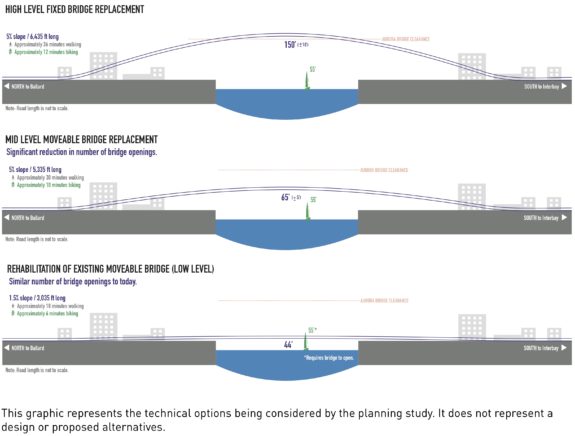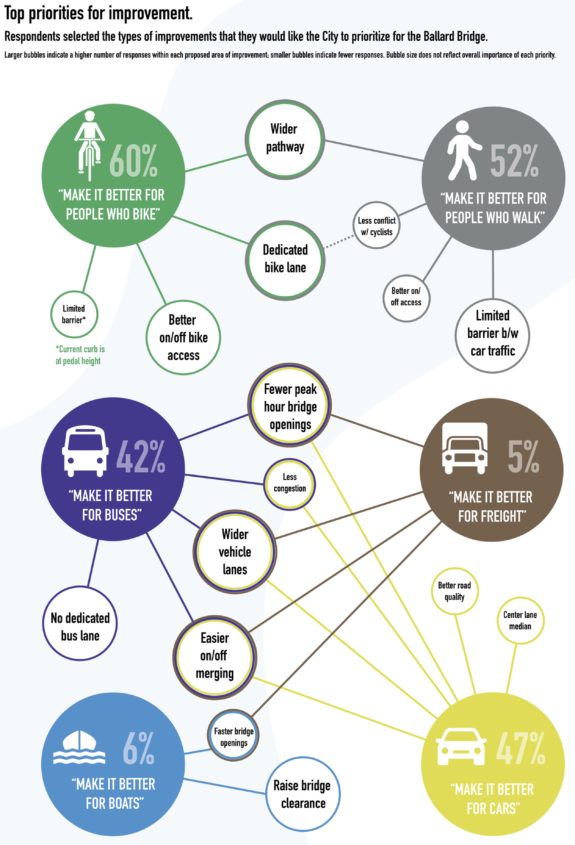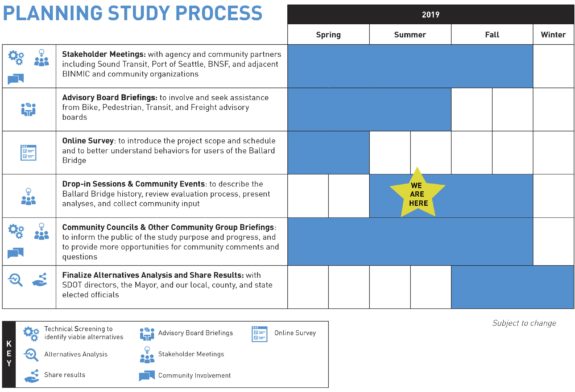
The city is currently conducting an early, fairly high-level study of the options for replacing the Ballard Bridge. The actual project is pretty far away and has no funding, but this study is intended to outline the pros and cons of various options and gather public feedback.
For a while, long-term planning for the Ballard Bridge was on pause because there was a chance Sound Transit was going to route light rail line over the bridge, which would have been a good excuse to rebuild it at the same time. But Sound Transit will dig a tunnel for the Ballard light rail line instead, so now it’s on the city to figure out what to do about the bridge. UPDATE: I jumped the gun here, sorry. It’s still not clear whether Sound Transit will pick a tunnel or elevated crossing, as the Urbanist reported recently. Environmental review will study multiple tunnel and bridge options.
The Move Seattle Levy included $700,000 to start planning the next Ballard Bridge, and the team plans to wrap up that study by the end of the year. The study will not even recommend a preferred alternative, but will provide information needed to take the next step for deeper analysis. Projects of this scale typically move very slowly, and the bridge is not a serious earthquake risk thanks to a seismic retrofit a few years ago.
However, the bridge is a serious bikeability and accessibility barrier due to its very skinny sidewalks. And this was apparent from their survey results, which saw a lot of participation from people who bike and walk (good work!).
 The city outlined three basic options for the bridge design: Remaking the current draw bridge profile, a somewhat taller draw bridge that would open less often and a bridge so tall it would never need to open.
The city outlined three basic options for the bridge design: Remaking the current draw bridge profile, a somewhat taller draw bridge that would open less often and a bridge so tall it would never need to open.
Unlike the Aurora Bridge, which is tall enough that it does not need a segment that can open, the Ballard Bridge approaches start much closer to the water level. That means the climb up to the bridge peak would likely be quite long and steep, including something like 100 feet of extra elevation compared to the current bridge. That’s a lot. The middle ground design would add a more reasonable 20 feet of extra climbing, and the remake would be about the same (of course).
The study does not include a level of detail deep enough to show exactly how the biking and walking connections would work. And there are also lots of questions about what to do about the approaches and ramps, some of which occupy a lot of land that could be put to better uses (especially on the south side). The Cascade Bicycle Club community group Connect Ballard outlined some of these ideas back in 2015.
Of course, long-term planning doesn’t help people using the bridge today, which can be very dangerous. The city still has not fixed the so-called “merge of death” at the south end of the west sidewalk even though people have been sounding the alarm about it for many years. And options for widening the sidewalks were found to be rather expensive. I have proposed building a bikeway on the bridge deck like the Burrard Bridge in Vancouver, BC.
Below is the timeline for the latest bridge study. For more, check out this recent post by Natalie Bicknell at the Urbanist.









Comments
16 responses to “Should the next Ballard Bridge be high, low or in between?”
I know a tunnel would be super expensive, but these bridge designs are ridiculous. We should just bite the bullet and build the tunnel.
Sorry, I misunderstood this. I thought we were still talking about a light rail bridge. Don’t mind me.
High level, no openings, same grade as mid level, seems like a good option. If you’re riding a bike in seattle you’re already dealing with grade change so having to go up a bridge isn’t a real problem. Choosing to go to ballard to spend money at anti bike businesses is the true issue here.
Why not build a new bridge for vehicular traffic (preferably a tall, non-drawbridge) while maintaining the existing bridge as predestrian / cycle only?
I’d bet most pedestrians and cyclists would be perfectly happy waiting for a drawbridge to open once in a blue moon if they knew they wouldn’t have to deal with cars and a significant climb.
It could even become a ‘Highline’ type park – add garden space in the media, maybe lease a space for a cafe, etc.
Let’s think outside the box (even though city planners can’t)
This is a great approach – I’m sure it would be tricky in the execution – but bridges without auto traffic are such pleasant places.https://en.wikipedia.org/wiki/Pyrmont_Bridge
I love this idea!
That’s a pretty creative idea I had never really considered.
It would be a significant task to acquire all the right of way to build a new bridge while also keeping the existing bridge. Are you suggesting tying into 15th Ave for this new bridge or where are you putting it. Just purchasing all of that very expensive land needed to build this bridge would take decades and cost as much money as the building the new bridge. Then there is also the cost of up keeping the existing Ballard bridge. I think City planners have thought of solutions like yours this but this is a bit impractical.
I would suspect that the current plan is to somehow build a new bridge *around* or *over* the existing bridge and tie that new bridge into 15th Avenue anyway, It’s not like tearing down the existing bridge and *then* building a new bridge in the exact same spot is an option – what would happen to traffic in the meantime?
When the new bridg it up and running, the existing bridge could then be ‘closed off’ or ‘disconnected’ and the ends, with only pedestrian access allowed (perhaps with new connections to the existing bike paths on each end).
This idea isn’t that radical. West Seattle ended up with two bridges: the older drawbridge, which was maintained for local access, and the high-rise West Seattle bridge to enhance mobility. The Murray Morgan Bridge in Tacoma was kept open to pedestrians even after it was closed to vehicular traffic (though in that case, it was eventually rehabilitated and reopened to all traffic).
As for “the cost of up keeping the existing Ballard bridge,” that might be a factor. I’m not sure what NYC has to spend on the Highline (which of course isn’t a drawbridge…) but it would be at least worth exploring. Maybe allowing businesses to open on the bridge would help defray any maintainence costs (via leases or other funding)? If the new bridge will be tolled (there hasn’t been a major new bridge built in WA recently that doesn’t include a toll…) perhaps some of that revenue would be used for the overall ‘complex’ of Salmon Bay crossings?
Finally, I’m less certain that “City planners have thought of solutions like yours this [sic] but this is a bit impractical.” It seems to me that city planners are more prone to following cookie-cutter ‘best practices’ and, when they do ‘innovate,’ end up giving us boondoggles like the SLUT.
The Highline in NYC wasn’t a ‘city planner’ idea – it was thought up by a small community group advocating the High Line’s preservation and transformation when the structure was threatened with demolition during Rudy Giuliani’s second term as mayor.
Late to the game, but I always thought that leaving the existing bridge as bus and bike/ped only would be an awesome idea. Two bus lanes in the middle and large bike/ped paths in the previous, exterior traffic lanes.
Light rail and general traffic would use a six lane submerged tunnel a la the BART Transbay Tube, three lanes on each side of the existing bridge, which likely has deep piles. Leary and Emerson would become standard, signalized, at-grade intersections.
Three (of many) issues I foresee are:
1. Like Tom brushed on, to get to the required depth under Salmon Bay, the road and rail approaches will have to reach a long way to the north and south, likely having the access portals near Market and Dravus.
2. While the traffic tunnel will bear the brunt of volumes, there’d still be some hyper local trips between Emerson and Leary, where forcing that traffic to backtrack up to the portals would require extensive 180 degree onramps or U-turns. This may necessitate the bus lanes to be general purpose lanes for these few trips. With a speed limit of 25 mph, narrow lanes, traffic lights and lots of buses, general traffic would hopefully avoid the bridge unless absolutely needed. Tolls may work, but that may drive legitimate bridge users up to the portals, resulting in awkward traffic patterns.
3. The previous bridge ratings for the Ballard Bridge were pretty dire, mostly due to underwater scour damage. This could be repaired, but at a large cost that would approach costs to replace the bridge. Unless the FTA becomes more transit/ped/bike friendly, I don’t see any funding to build a bus/bike bridge AND a rail/traffic tunnel.
If ST is digging a train tunnel then why not add a motor vehicle and pedestrian/bike tunnel at the same time. Then they can remove the bridge.
[…] Seattle Bike Blog looks at the options for a replacement Ballard Bridge. […]
Tom, Sound Transit has not decided what the Salmon Bay crossing will be. Could be a bridge or could be a tunnel.
https://www.soundtransit.org/sites/default/files/documents/west-seattle-ballard-link-extensions-project-map.pdf
Hey, you’re right. I jumped the gun there. I know there’s a ton of support for a Ballard tunnel and thought it was more of a sure thing. I’ll update the post. This Urbanist post has more details: https://www.theurbanist.org/2019/07/16/sound-transit-closing-in-on-tacoma-dome-ballard-and-west-seattle-options-to-make-eis-cut/
Can a path be put under the bridge like this one in Austin?
https://www.google.com/maps/@30.274962,-97.7709918,2a,75y,246.96h,84.02t/data=!3m6!1e1!3m4!1s3MeFpwuEUeZbqU8SmMQgYQ!2e0!7i13312!8i6656
A low bridge is vastly better for biking and pedestrian access. It’s not just about the total grade and distance of the bridge itself, it’s also that a longer bridge forces users to double back farther to get to places close to the canal… including both the Burke-Gilman and South Ship Canal Trail! There’s a similar problem for transit. Today the D Line stops at Leary for connections to the 40 and access to many destinations near the canal, and at Emerson, too, though the poor pedestrian network there makes that stop less useful than it could be. With a low bridge these stops are easy to make; with a high bridge it would be much more difficult.
Additionally extending the bridge would extend an elevated highway and pedestrian-hostile landing infrastructure deeper into Ballard. Today Ballard Way, 49th, and 50th are blocked from crossing 15th by the bridge approach and there’s a big interchange at the first exit, at Leary. A longer, taller bridge probably couldn’t support a Leary exit. Would essentially all the traffic from the bridge then have to go through 15th/Market at-grade? Would we build another big surface intersection south of there to cut off all the traffic heading back toward the canal? Or would we build an overpass of Market, like today’s overpass of Leary but bigger? Surely none of this is what we want right next to what’s going to be Ballard’s most important transit station!